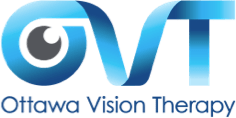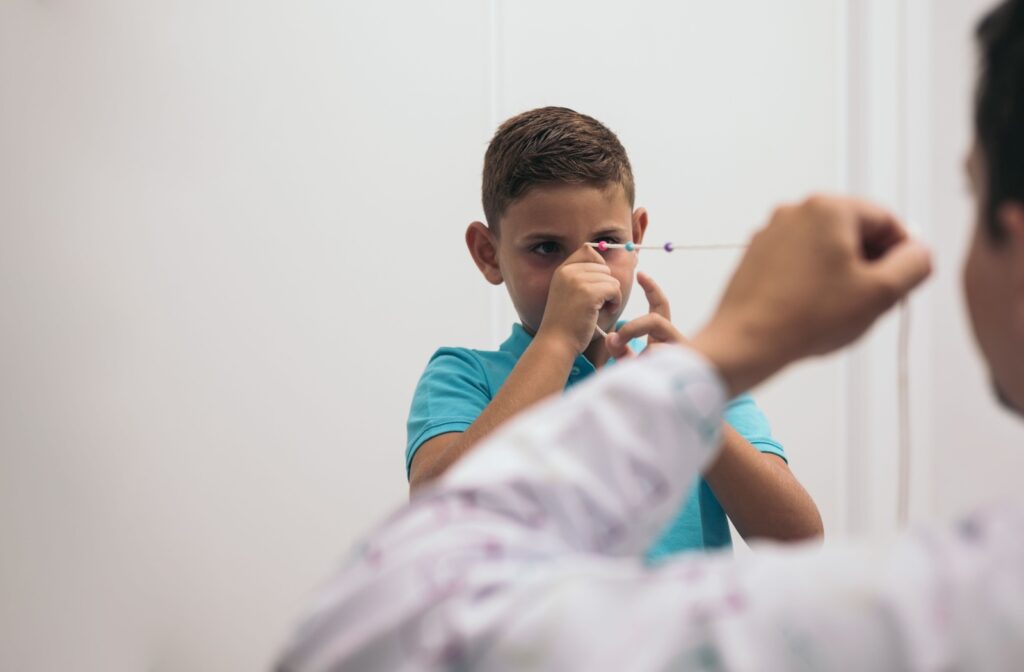Reading plays an important role in a child’s academic success and personal development. However, some children face difficulties with reading—not due to a lack of motivation or intelligence but because of underlying vision issues. These challenges often go unnoticed, potentially affecting school performance and confidence.
Vision therapy can support reading development by improving eye coordination, tracking, visual processing, and more. Some children who experience reading difficulties have undiagnosed vision issues, such as convergence insufficiency or difficulty maintaining focus, which can cause text to appear blurry or unstable. Vision therapy incorporates structured exercises and guided training with an optometrist and vision therapist to strengthen eye control, improve focus, and promote smoother, more efficient reading.
The Link Between Vision & Learning
Did you know that up to 80% of learning is visual? Vision plays an important role in a child’s ability to read, comprehend, and retain information. Children who struggle with vision-related
challenges may face difficulties such as skipping lines, struggling to identify words, or even experiencing headaches. Over time, these challenges can contribute to academic setbacks and feelings of frustration.
Additionally, vision problems are often misdiagnosed as behavioral issues or learning disabilities, such as ADHD or dyslexia. Children are left navigating unnecessary hurdles that hinder their educational progress and emotional well-being without proper intervention.
Research supports the importance of clear, stable vision for academic success. Early diagnosis and treatment of vision problems can positively impact a child’s reading development and confidence.
Recognizing Vision-Related Challenges
Spotting the signs of vision issues early is helpful for effective intervention. Here are some indicators that a child might have vision problems impacting their reading ability:
- Skipping or rereading lines while reading
- Squinting, frequent blinking, or rubbing their eyes
- Complaints of blurred or double vision
- Holding books or reading materials very close to their face
- Tilting their head or covering one eye
- Frequent headaches or eye strain after reading
If you notice any of these signs in your child, it’s time to schedule a comprehensive eye examination with an optometrist. Early diagnosis is the first step to improved reading skills and academic confidence.
What is Vision Therapy?
Vision therapy is a specialized, non-invasive treatment program designed to improve how the eyes work together and process visual information. Unlike glasses or contact lenses, which correct refractive errors, vision therapy focuses on strengthening the visual system to address problems like poor eye coordination, focusing challenges, and visual perception difficulties.
Therapy programs are personalized to each child’s unique needs and consist of in-office sessions and at-home exercises. Guided by an optometrist or vision therapist, children engage in practical activities that can develop their visual skills and improve reading capabilities.
How Does Vision Therapy Improve Reading Skills?
Vision therapy targets fundamental visual functions that can impact reading. Here’s how specific techniques contribute to better reading performance:
Eye Tracking
Eye tracking—or the ability to follow a moving object or line of text smoothly—is important for reading fluency. Vision therapy uses exercises to strengthen a child’s tracking skills, helping them stay on the correct line and avoid skipping words.
Improving Focusing Ability
Some children struggle to maintain clear vision when switching focus between distances or focusing on text for prolonged periods. Focusing activities and techniques in vision therapy train the eyes to adjust quickly and reduce strain, making reading easier for extended periods.
Strengthening Binocular Vision
Good reading requires both eyes to work together. Vision therapy includes binocular vision training exercises that improve coordination between the two eyes. This avoids issues like double vision or difficulty maintaining visual focus on a page.
Improved Visual Processing
Even when the eyes provide clear input, some children struggle with interpreting what they see. Vision therapy improves visual processing and helps make it easier for children to recognize letters, words, and patterns.

Getting Started with Vision Therapy
Here are a few steps to get started with vision therapy today:
- Schedule a comprehensive eye exam: Book an appointment with an optometrist who specializes in pediatric vision care and therapy. This allows for a thorough assessment of your child’s visual skills and the identification of any issues.
- Develop a personalized plan: The optometrist will create a therapy program designed to address your child’s unique needs. Programs typically involve weekly sessions over the course of a few months, with supplemental exercises to practice at home.
- Stay consistent: Follow the prescribed schedule, encourage your child’s participation in at-home exercises, and communicate regularly with the vision therapist to monitor progress.
- Monitor Progress: Improvement doesn’t happen overnight, but small milestones along the way will build toward better reading skills and confidence.
The Benefits of Vision Therapy for Children
By addressing vision challenges at their root, vision therapy offers a range of potential benefits for children struggling with reading, including:
- Improved reading fluency and comprehension
- Enhanced academic performance
- Reduced headaches and eye strain
- Increased confidence in reading and learning
- A more positive attitude toward school and learning
These changes go far beyond reading; they foster a greater sense of independence and achievement in all areas of life.
Get Started Today
Schedule an appointment with Ottawa Vision Therapy today. Our experienced team of optometrists and vision therapists is here to answer your questions and guide you through vision therapy, helping children strengthen their reading skills and build confidence.




